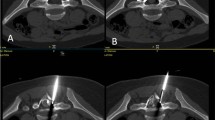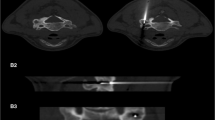Abstract
Study Design
Retrospective. Level IV Evidence.
Objective
To assess the utility of intraoperative neurophysiological monitoring (IONM) to detect and eventually prevent impending neurovascular damage during computed tomography (CT)-guided radiofrequency ablation (RFA) of spinal osteoid osteoma (OO) in children.
Summary and Background Data
To our knowledge, this is the first case series of spinal OO in pediatric patients treated at a single center employing IONM during RFA.
Methods
This is a retrospective study of seven consecutive patients (3 girls and 4 boys, mean age: 9 years 4 months) with imaging and clinical signs compatible with spinal OO who underwent CT-guided RFA, under general anesthesia, and IONM in a single center between 2011 and 2015. Before the RFA procedure, a CT-guided percutaneous biopsy of the nidus was performed in the same setting. RFA was divided into four cycles of increasing time and temperature and performed under IONM in every patient.
Results
Two patients had lesions located in the thoracic spine and five patients had lumbar involvement. The RFA technical and clinical success was 85.7%. Six patients presented with reversible neurophysiological changes either during biopsy needle positioning or RFA cycles. In the remaining case, as IONM changes did not improve after several minutes of neuroprotective hypertension, the procedure was interrupted. Neither neurologic nor vascular complications were observed after RFA treatment. In only one biopsy sample, OO was confirmed by histopathologic studies.
Conclusion
CT-guided RFA is an accepted minimally invasive technique for the treatment of spinal OO in children. IONM may be a helpful tool that requires minimal additional time and provides feedback on the state of the spinal cord and nerves at risk during the procedure. We promote the use of IONM during these procedures to detect and possibly prevent impending neurologic damage.
Level of Evidence
Level IV.
Similar content being viewed by others
References
Bergstrand H. Über eine eigenartige, wahrscheinlich bisher nicht beschriebene osteoblastische Krankheit in den langen Knochen der Hand und des Fusses. Acta Radiol 1930;11:596.
Jaffe H. A benign osteoblastic tumor composed of osteoid and atypical bone. Arch Surg 1935;31:709–28.
Rehnitz C, Sprengel SD, Lehnerb B, et al. CT-guided radiofrequency ablation of osteoid osteoma and osteoblastoma: clinical success and long-term follow up in 77 patients. Eur J Radiol 2012;81:3426–34.
Hadjipavlou AG, Tzermiadianos MN, Kakavelakis KN, et al. Percutaneous core excision and radiofrequency thermo-coagulation for the ablation of osteoid osteoma of the spine. Eur Spine J 2009;18:345–51.
Weber MA, Sprengel SD, Omlor GW, et al. Clinical long-term outcome, technical success, and cost analysis of radiofrequency ablation for the treatment of osteoblastomas and spinal osteoid osteomas in comparison to open surgical resection. Skeletal Radiol 2015;44:981–93.
Morassi LG, Kokkinis K, Evangelopoulos DS, et al. Percutaneous radiofrequency ablation of spinal osteoid osteoma under CT guidance. Br J Radiol 2014;87:20140003.
Mylona S, Patsoura S, Galani P, et al. Osteoid osteomas in common and in technically challenging locations treated with computed tomography-guided percutaneous radiofrequency ablation. Skeletal Radiol 2010;39:443–9.
Tello CA, Bersusky E, Noel M, et al. Osteoma Osteoide en la Columna Pediátrica. Revista de la Asociación Argentina de Ortopedia y Traumatología 1995;60:111–25.
Rybak LD, Gangi A, Buy X, et al. Thermal ablation of spinal osteoid osteomas close to neural elements: technical considerations. AJR Am J Roentgenol 2010;195:W293–8.
Ozaki T, Liljenqvist U, Hillmann A. Osteoid osteomas and osteoblastoma of the spine: experiences with 22 patients. Clin Orthop Relat Res 2002;397:394–402.
Vanderschueren GM, Obermann WR, Dijkstra SP, et al. Radiofrequency ablation of spinal osteoid osteoma. Clinical outcome. Spine 2009;34:901–3.
Rosenthal DI, Hornicek FJ, Torriani M. Osteoid osteoma: percutaneous treatment with radiofrequency energy. Radiology 2003;229:171–5.
Cantwell CP, O’Byrne J, Eustace S. Radiofrequency ablation of osteoid osteoma with cooled probes and impedance-control energy delivery. AJR Am J Roentgenol 2006;186:S244–8.
Wortler K, Vestring T, Boettner F, et al. Osteoid osteoma: CT-guided percutaneous radiofrequency ablation and follow-up in 47 patients. J Vasc Interv Radiol 2001;2:717–22.
Rosenthal DI, Springfield DS, Gebhardt MC, et al. Osteoid osteoma: percutaneous radio-frequency ablation. Radiology 1995;197:451–4.
Lindner NJ, Scarborough M, Ciccarelli JM, et al. CT controlled thermocoagulation of osteoid osteoma in comparison with traditional methods. Z OrthopIhre Grenzgeb 1997;135:522–7.
Theumann N, Hauser P, Schmidt S, et al. Osteoid osteoma and radiofrequency. Rev Med Suisse 2005;1:2989–94.
Owen JW, Bridwell KH, Gilula LA. Management of complications following radiofrequency ablation of a pedicle osteoid osteoma. Am J Orthop 2014;43:E124–8.
Dupuy DE, Hong R, Oliver B, et al. Radiofrequency ablation of spinal tumors: temperature distribution in the spinal canal. AJR Am J Roentgenol 2000;175:1263–6.
Brodkey JS, Miyazaki Y, Ervin FR, et al. Reversible heat lesions with radiofrequency current. A method of stereotactic localization. J Neurosurg 1964;21:49–53.
Bunch TJ, Bruce GK, Mahapatra S, et al. Mechanisms of phrenic nerve injury during radiofrequency ablation at the pulmonary vein orifice. J Cardiovasc Electrophysiol 2005;16:1318–25.
Adachi A, Kaminou T, Ogawa T. Heat distribution in the spinal canal during radiofrequency ablation for vertebral lesions: study in swine. Radiology 2008;247:374–80.
Maarrawi J, Kobaiter-Maarrawi S, Ghanem I, et al. Pathological effects and motor response threshold changes following radiofrequency application at various distances from the L-5 nerve root: an experimental study. Neurosurg Sine 2011;15:285–91.
Marshall RH, Avila EK, Solomon SB, et al. Feasibility of intraoperative nerve monitoring in preventing thermal damage to the “nerve at risk” during image-guided ablation of tumors. Cardiovasc Intervent Radiol 2016;39:875–84.
Laus M, Albisinni U, Alfonso C, et al. Osteoid osteoma of the cervical spine: surgical treatment or percutaneous radiofrequency coagulation? Eur Spine J 2007;16:2078–82.
Rosenthal DI, Alexander A, Rosenberg AE, et al. Ablation of osteoid osteomas with a percutaneously placed electrode: a new procedure. Radiology 1992;183:29–33.
Kneisl JS, Simon MA. Medical management compared with operative treatment for osteoid osteoma. J Bone Joint Surg Am 1992;74–A:179–85.
Barsa P, Suchomel P, Lukás R, et al. Percutaneous CT-guided radiofrequency ablation in spinal osteoid osteoma treatment. Acta Chir Orthop Traumatol Cech 2007;74:401–5.
Fehlings MG, Brodke DS, Norvell DC, et al. The evidence for intraoperative neurophysiological monitoring in spine surgery: does it make a difference? Spine (Phila Pa 1976) 2010;35(9 Suppl):S37–46.
Gonzalez AA, Jeyanandarajan D, Hansen C, et al. Intraoperative neurophysiological monitoring during spine surgery: a review. Neurosurg Focus 2009;27:E6.
Sutter M, Eggspuehler A, Grob D, et al. The validity of multimodal intraoperative monitoring (MIOM) in surgery of 109 spine and spinal cord tumors. Eur Spine J 2007;16(Suppl 2):S197–208.
Nuwer MR, Emerson RG, Galloway G, et al. Therapeutics and Technology Assessment Subcommittee of the American Academy of Neurology; American Clinical Neurophysiology Society. Evidence-based guideline update: intraoperative spinal monitoring with somatosensory and transcranial electrical motor evoked potentials: report of the Therapeutics and Technology Assessment Subcommittee of the American Academy of Neurology and the American Clinical Neurophysiology Society. Neurology 2012;78:585–9.
Cove JA, Taminiau AH, Obermann WR, et al. Osteoid osteoma of the spine treated with percutaneous computed tomography guided thermocoagulation. Spine 2000;25:1283–6.
Samaha EI, Ghanem IB, Moussa RF, et al. Percutaneous radiofrequency coagulation of osteoid osteoma of the neural spine ring. Eur Spine J 2005;14:702–5.
Sutphen SA, Murakami JW. Radiofrequency ablation of a cervical osteoid osteoma: a trans-thyroid approach. Pediatr Radiol 2007;37:83–5.
Nour SG, Aschoff AJ, Mitchell I, et al. MR imaging-guided radiofrequency thermal ablation of the lumbar vertebrae in porcine models. Radiology 2002;224:452–62.
Boss A, Clasen S, Kuczyk M, et al. Thermal damage of the genitofemoral nerve due to radiofrequency ablation of renal cell carcinoma: a potentially avoidable complication. AJR Am J Roentgenol 2005;185:1627–31.
Wang H, Littrup PJ, Duan Y, et al. Thoracic masses treated with percutaneous cryotherapy: initial experience with more than 200 procedures. Radiology 2005;235:289–98.
Hiraki T, Gobara H, Mimura H, et al. Brachial nerve injury caused by percutaneous radiofrequency ablation of apical lung cancer: a report of four cases. J Vasc Interv Radiol 2010;21:1129–33.
Matsui Y, Hiraki T, Gobara H, et al. Phrenic nerve injury after radiofrequency ablation of lung tumors: retrospective evaluation of the incidence and risk factors. J Vasc Interv Radiol 2012;23:780–5.
Atwell TD, Carter RE, Schmit GD, et al. Complications following 573 percutaneous renal radiofrequencies and cryoablation procedures. J Vasc Interv Radiol 2012;23:48–54.
Coskun DJ, Gilchrist J, Dupuy D. Lumbosacral radiculopathy following radiofrequency ablation therapy. Muscle Nerve 2003;28:754–6.
Kashima M, Yamakado K, Takaki H, et al. Complications after 1000 lung radiofrequency ablation sessions in 420 patients: a single center’s experiences. AJR Am J Roentgenol 2011;197:W576–80.
Kumar RS, Gopinath M. A rare cause of foot drop after radiofrequency ablation for varicose veins: case report and review of the literature. Neurol India 2010;58:303–5.
Munk PL, Rashid F, Heran MK, et al. Combined cementoplasty and radiofrequency ablation in the treatment of painful neoplastic lesions of bone. J Vasc Interv Radiol 2009;20:903–11.
Rutkove SB. Effects of temperature on neuromuscular electrophysiology. Muscle Nerve 2001;24:867–82.
Mazoyer JF, Kohler R, Bossard D. Osteoid osteoma: CT-guided percutaneous treatment. Radiology 1991;181:269–71.
Author information
Authors and Affiliations
Corresponding author
Additional information
Author disclosures
MAN (none); MJS (none); SS (none); WIAF (none); CAT (grants from Biomet, during the conduct of the study); EG (none); RGR (none); MET (none); ESB (none); LP (none).
Rights and permissions
About this article
Cite this article
Nöel, M.A., Segura, M.J., Sierre, S. et al. Neurophysiological Monitoring in Radiofrequency Ablation of Spinal Osteoid Osteoma With a Progressive Time and Temperature Protocol in Children. Spine Deform 5, 351–359 (2017). https://doi.org/10.1016/j.jspd.2017.03.001
Received:
Revised:
Accepted:
Published:
Issue Date:
DOI: https://doi.org/10.1016/j.jspd.2017.03.001




